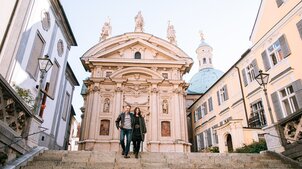Palais Saurau
Assault from above? A man with a beard, turban and dagger gazes down threateningly, capturing the attention of passers-by. It’s OK, the well-known Turk under the roof decorates one of the finest buildings in the city. On a stroll through Graz it’s always worth taking in Palais Saurau. With its Baroque, richly decorated wrought iron gate, Renaissance arcades in the courtyard and splendidly decorated first-floor halls, the palace invites you to immerse yourself in the history of the Saurau family.

Details
In 1566 Pankraz von Windischgrätz erected a large-scale four-wing palais near the then still existing medieval town wall. A narrow alley between the house and the town wall was part of an escape route from the Burg to the fortress on the Schlossberg, which could be used by Archduke Charles II in case of an enemy attack. Since 1630 the building has been owned by the family of Saurau, today Goess-Saurau. In the 18th century the Counts of Saurau were eager to make the palais Baroque. It was especially the state halls which at that time were given their homogenous interior still remarkably complete. Around 1730 the impressive fanlight of the gateway was made. It ranks among the best Baroque wrought-iron works in Styria. On its side towards Schlossberg , the vast inner courtyard is characterized by galleries from the Renaissance period. The paving with small rounded stones from
the river Mur - lovingly called "Murnockerln" (Mur dumplings) by the locals - is typical of Graz.
Those who did/do not find rest in the stately house could/can retire to the summer house on the slope of Schlossberg. The domed Baroque gem is so secret that it can hardly be spied from any place in Graz.
But what about the Turk looking out of Palais Saurau? There are lots of legends. This one, for instance: the Turks had taken Graz, except the fortress on the Schlossberg. When a Turkish pasha was having dinner in today's Palais Saurau, a cannon ball shot from Schlossberg hit his plate with the delicious roast. The latter flew out of the window. What else could he do but gaze after it? In his rage, he ordered the withdrawal of the Turks from Graz. As in fact, however, the Turks have never occupied Graz, the story must have been different. Opinions about the original function of the wooden figure with Turkish features are divided. Maybe the Counts of Saurau just followed a fashion which caught on after the great victory over the Turks in 1683, and decorated their house "alla turca".
By the way: It was a member of the Saurau family (though none from Graz), Franz Josef, who in his position as secretary of state wanted to please Emperor Franz with a birthday surprise in 1797. Composer Joseph Haydn and poet Lorenz Haschka wrote an anthem starting off with the words "Gott erhalte Franz, den Kaiser, unsern guten Kaiser Franz". Till the collapse of the monarchy in 1918, this "Kaiserhymne" was to remain the official anthem of the Hapsburg Empire. The melody is living on in Haydn's "Kaiserquartett" - and in the national anthem of Germany.




